The T.incomingtracker.com is a web site that created to redirect you web browser to other ad web-pages. If the MS Edge, Mozilla Firefox, Google Chrome and Microsoft Internet Explorer shows this web page then it is possible that a PUP from the adware family get installed on your system. The adware is an undesired software which is going to display you a lot of popup advertisements and deals. Of course, it is not a malware or virus in the “general meaning” of this word. It will not delete or damage your files, but it can change some personal computer’s settings or download and install other harmful software. So, you’d better to delete adware using the guidance below and thus delete T.incomingtracker.com popup advertisements.
http://t.incomingtracker.com/ …
While your computer is infected by the ad-supported software, the Mozilla Firefox, Chrome, MS Edge and IE may be redirected to T.incomingtracker.com annoying web-site. Of course, the ad supported software may not cause damages to your files or Windows system, but it may open a ton of unwanted advertisements. These advertisements will be injected within the content of sites that are you opening in your internet browser and can be varied: pop-up ads, in-text ads, different sized banners, offers to install an questionable software. The ads will appear on all webpages, including websites where previously you have never seen any advertising links.
The ad supported software can modify the settings of the Google Chrome, Mozilla Firefox, Edge and Internet Explorer, but often that a harmful software such as this can also hijack all types of internet browsers by modifying their desktop shortcut files. Thus forcing the user each time run the internet browser to see the annoying T.incomingtracker.com site.
The guidance below explaining steps to delete T.incomingtracker.com redirect problem. Feel free to use it for removal of the ad-supported software that may attack MS Edge, Google Chrome, Internet Explorer and Mozilla Firefox and other popular web-browsers. The steps will allow you delete adware and thereby clean your browser from all undesired ads.
How to remove T.incomingtracker.com redirect
As with removing adware, malware or potentially unwanted apps, there are few steps you may do. We suggest trying them all. If you do only one part of the tutorial, then it should be run malicious software removal utility, because it should get rid of adware and block any further infection. But to completely delete T.incomingtracker.com popup ads you’ll have to at least reset your browser settings such as newtab, search provider and home page to default state, disinfect system’s web-browsers shortcuts, delete all unwanted and suspicious software, and get rid of adware by malware removal utilities. Certain of the steps will require you to restart your PC or shut down this webpage. So, read this guidance carefully, then bookmark or print it for later reference.
To remove T.incomingtracker.com, use the steps below:
- Get rid of T.incomingtracker.com popup advertisements without any tools
- Removing the T.incomingtracker.com, check the list of installed apps first
- Remove unwanted Scheduled Tasks
- Remove T.incomingtracker.com popup ads from Chrome
- Get rid of T.incomingtracker.com redirect from Mozilla Firefox
- Remove T.incomingtracker.com advertisements from Internet Explorer
- Fix affected browsers shortcuts to remove T.incomingtracker.com redirect
- Scan your PC and remove T.incomingtracker.com pop-up ads with free utilities
- Block T.incomingtracker.com pop ups and other intrusive web-sites
- Tips to prevent T.incomingtracker.com popup ads and other unwanted software
- Finish words
Get rid of T.incomingtracker.com popup advertisements without any tools
Read this “How to remove” section to know how to manually remove ad supported software that causes lots of undesired T.incomingtracker.com pop ups. Even if the step-by-step instructions does not work for you, there are several free malware removers below that can easily handle such adware responsible for redirecting your browser to T.incomingtracker.com website.
Removing the T.incomingtracker.com, check the list of installed apps first
First of all, check the list of installed software on your PC system and uninstall all unknown and recently installed apps. If you see an unknown application with incorrect spelling or varying capital letters, it have most likely been installed by malware and you should clean it off first with malware removal utility like Zemana Anti-malware.
Press Windows button ![]() , then press Search
, then press Search ![]() . Type “Control panel”and press Enter. If you using Windows XP or Windows 7, then click “Start” and select “Control Panel”. It will display the Windows Control Panel like below.
. Type “Control panel”and press Enter. If you using Windows XP or Windows 7, then click “Start” and select “Control Panel”. It will display the Windows Control Panel like below.

Further, click “Uninstall a program” ![]()
It will display a list of all software installed on your machine. Scroll through the all list, and delete any suspicious and unknown applications.
Remove unwanted Scheduled Tasks
Once installed, the adware can add a task in to the Windows Task Scheduler Library. Due to this, every time when you launch your machine, it will open T.incomingtracker.com annoying web-site. So, you need to check the Task Scheduler Library and remove all malicious tasks that have been created by malicious program.
Press Windows and R keys on your keyboard together. It will display a prompt that called Run. In the text field, type “taskschd.msc” (without the quotes) and click OK. Task Scheduler window opens. In the left-hand side, click “Task Scheduler Library”, like below.
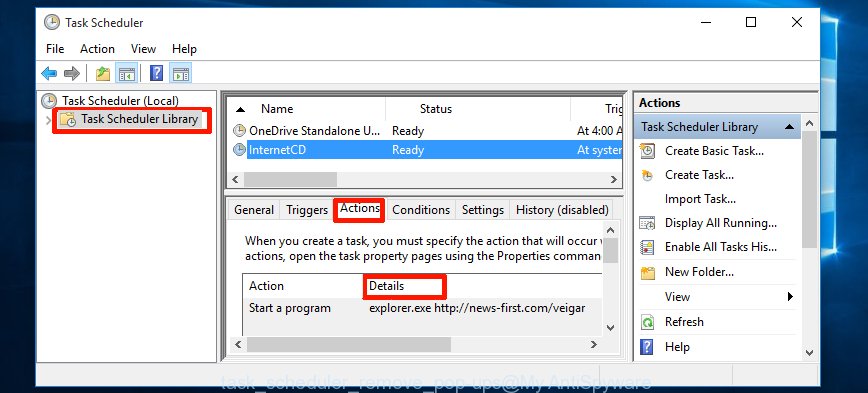
Task scheduler, list of tasks
In the middle part you will see a list of installed tasks. Select the first task, its properties will be open just below automatically. Next, press the Actions tab. Necessary to look at the text which is written under Details. Found something such as “explorer.exe http://site.address” or “chrome.exe http://site.address” or “firefox.exe http://site.address”, then you need remove this task. If you are not sure that executes the task, then google it. If it is a component of the unwanted software, then this task also should be removed.
Further press on it with the right mouse button and select Delete as displayed below.

Task scheduler, delete a task
Repeat this step, if you have found a few tasks that have been created by adware. Once is done, close the Task Scheduler window.
Remove T.incomingtracker.com popup ads from Chrome
Reset Chrome settings is a simple way to remove the hijacker infections, malicious and ‘ad-supported’ extensions, as well as to recover the internet browser’s startpage, newtab page and default search provider that have been modified by ad-supported software that responsible for browser redirect to the annoying T.incomingtracker.com web-page.

- First launch the Google Chrome and press Menu button (small button in the form of three dots).
- It will display the Chrome main menu. Select More Tools, then click Extensions.
- You’ll see the list of installed plugins. If the list has the addon labeled with “Installed by enterprise policy” or “Installed by your administrator”, then complete the following steps: Remove Chrome extensions installed by enterprise policy.
- Now open the Chrome menu once again, click the “Settings” menu.
- You will see the Chrome’s settings page. Scroll down and click “Advanced” link.
- Scroll down again and click the “Reset” button.
- The Google Chrome will show the reset profile settings page as shown on the screen above.
- Next click the “Reset” button.
- Once this process is finished, your browser’s newtab, search engine by default and homepage will be restored to their original defaults.
- To learn more, read the article How to reset Google Chrome settings to default.
Get rid of T.incomingtracker.com redirect from Mozilla Firefox
The Mozilla Firefox reset will keep your personal information such as bookmarks, passwords, web form auto-fill data, restore preferences and security settings, get rid of redirects to unwanted T.incomingtracker.com web-page and adware.
First, launch the Mozilla Firefox and press ![]() button. It will open the drop-down menu on the right-part of the web browser. Further, click the Help button (
button. It will open the drop-down menu on the right-part of the web browser. Further, click the Help button (![]() ) as shown in the following example.
) as shown in the following example.

In the Help menu, select the “Troubleshooting Information” option. Another way to open the “Troubleshooting Information” screen – type “about:support” in the browser adress bar and press Enter. It will display the “Troubleshooting Information” page like below. In the upper-right corner of this screen, click the “Refresh Firefox” button.

It will show the confirmation dialog box. Further, click the “Refresh Firefox” button. The Firefox will begin a task to fix your problems that caused by the adware which redirects your browser to undesired T.incomingtracker.com web site. Once, it’s finished, click the “Finish” button.
Remove T.incomingtracker.com advertisements from Internet Explorer
By resetting Microsoft Internet Explorer internet browser you return your web-browser settings to its default state. This is first when troubleshooting problems that might have been caused by ad supported software that causes multiple intrusive pop up advertisements.
First, launch the Internet Explorer. Next, click the button in the form of gear (![]() ). It will open the Tools drop-down menu, click the “Internet Options” as shown in the following example.
). It will open the Tools drop-down menu, click the “Internet Options” as shown in the following example.

In the “Internet Options” window click on the Advanced tab, then click the Reset button. The Internet Explorer will show the “Reset Internet Explorer settings” window as shown in the following example. Select the “Delete personal settings” check box, then press “Reset” button.

You will now need to restart your machine for the changes to take effect.
Fix affected browsers shortcuts to remove T.incomingtracker.com redirect
Once the adware is started, it can also change the web-browser’s shortcuts, adding an argument like “http://site.address” into the Target field. Due to this, every time you open the internet browser, it will show an unwanted site.
Right click on the shortcut file of infected internet browser as displayed in the following example.
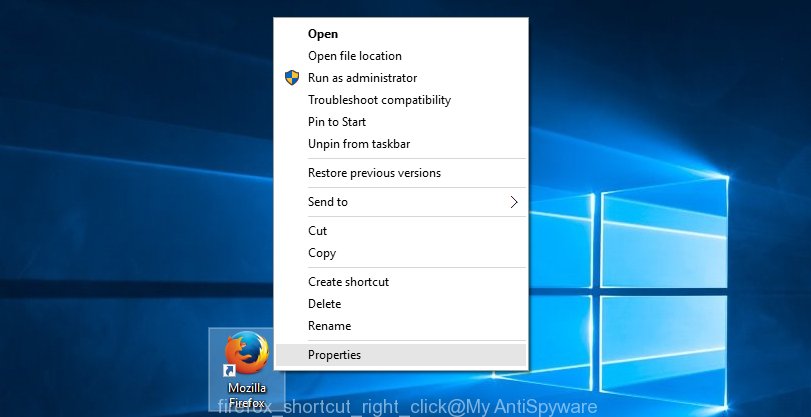
Select the “Properties” option and it’ll open the shortcut’s properties. Next, click the “Shortcut” tab and then delete the “http://site.address” string from Target field as shown on the image below.
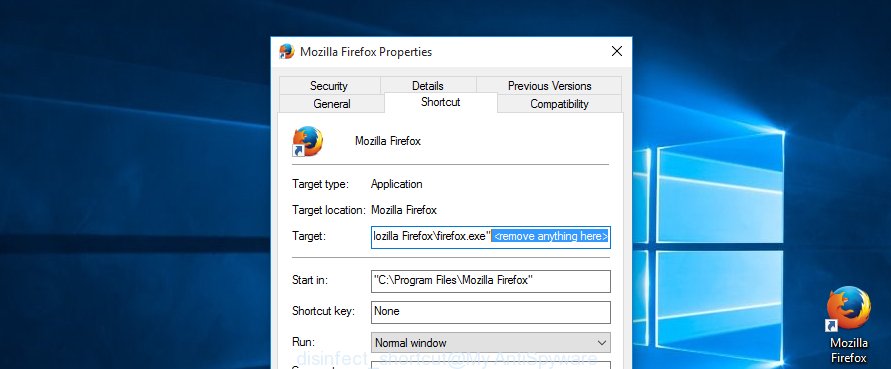
Then press OK to save changes. Repeat the step for all browsers which are re-directed to the T.incomingtracker.com undesired web site.
Scan your PC and remove T.incomingtracker.com pop-up ads with free utilities
If you are not expert at computers, then all your attempts to remove T.incomingtracker.com pop up ads by following the manual steps above might result in failure. To find and remove all of the adware related files and registry entries that keep this adware on your PC, use free anti malware software like Zemana Free, MalwareBytes Free and HitmanPro from our list below.
Run Zemana Anti-malware to get rid of T.incomingtracker.com pop-up advertisements
Zemana Anti-malware is a utility that can remove ad supported software, PUPs, hijackers and other malware from your computer easily and for free. Zemana Anti-malware is compatible with most antivirus software. It works under Windows (10 – XP, 32 and 64 bit) and uses minimum of computer resources.
Download Zemana on your Microsoft Windows Desktop by clicking on the following link.
165079 downloads
Author: Zemana Ltd
Category: Security tools
Update: July 16, 2019
Once the downloading process is finished, close all programs and windows on your personal computer. Open a directory in which you saved it. Double-click on the icon that’s named Zemana.AntiMalware.Setup as displayed in the following example.
![]()
When the installation starts, you will see the “Setup wizard” which will help you install Zemana on your system.

Once installation is finished, you will see window as shown in the figure below.

Now click the “Scan” button for scanning your system for the adware which causes annoying T.incomingtracker.com pop up ads. While the tool is checking, you may see how many objects and files has already scanned.

As the scanning ends, a list of all items found is created. Once you’ve selected what you want to remove from your personal computer click “Next” button.

The Zemana will remove adware that responsible for the appearance of T.incomingtracker.com pop-up advertisements and move threats to the program’s quarantine.
Use HitmanPro to remove T.incomingtracker.com popup advertisements from web-browser
HitmanPro is a free tool which can identify adware responsible for redirecting your browser to T.incomingtracker.com webpage. It is not always easy to locate all the unwanted software that your machine might have picked up on the World Wide Web. HitmanPro will find the adware, browser hijackers and other malware you need to remove.
Visit the following page to download Hitman Pro. Save it on your Desktop.
After the download is finished, open the directory in which you saved it and double-click the HitmanPro icon. It will start the HitmanPro utility. If the User Account Control dialog box will ask you want to open the program, click Yes button to continue.
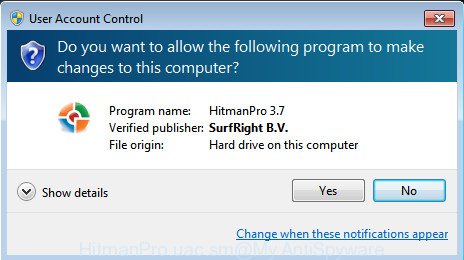
Next, press “Next” . Hitman Pro program will scan through the whole computer for the ad supported software that developed to redirect your web-browser to various ad sites like T.incomingtracker.com. While the Hitman Pro is checking, you can see how many objects it has identified either as being malware.
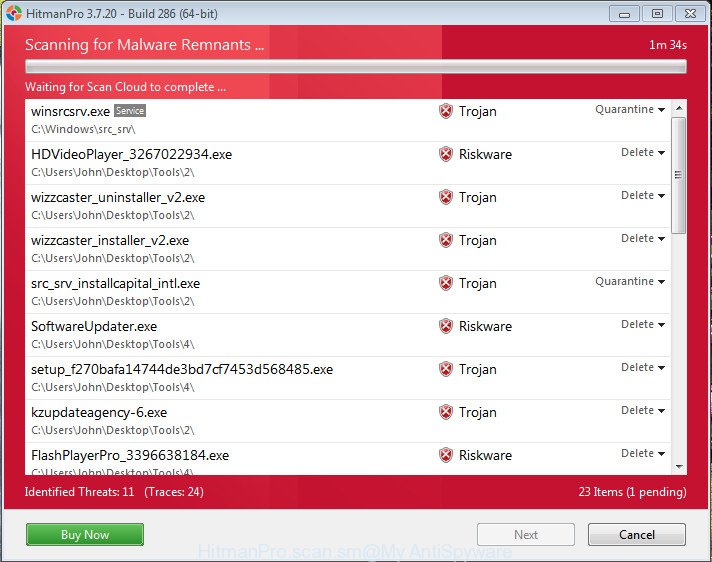
Once the scanning is finished, HitmanPro will display a list of found threats as displayed in the figure below.
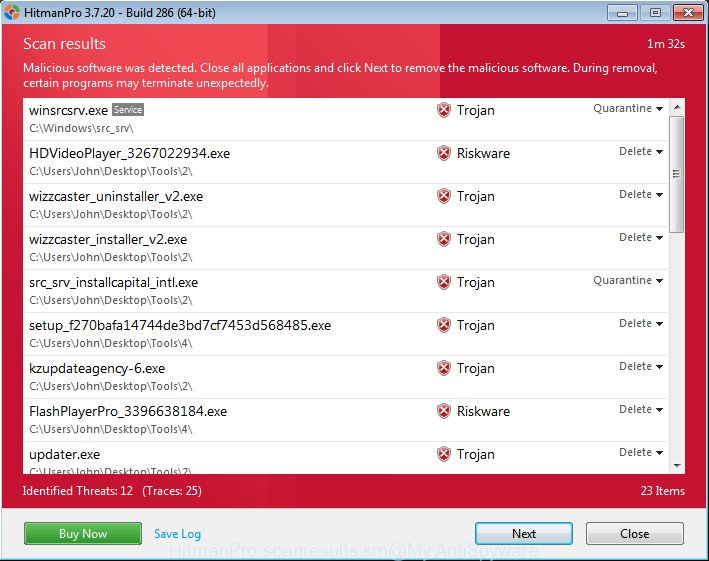
Review the results once the utility has finished the system scan. If you think an entry should not be quarantined, then uncheck it. Otherwise, simply press “Next” button. It will show a dialog box, click the “Activate free license” button. The HitmanPro will get rid of ad-supported software that causes unwanted T.incomingtracker.com pop-up ads and move items to the program’s quarantine. Once finished, the tool may ask you to reboot your system.
Automatically remove T.incomingtracker.com pop-ups with Malwarebytes
Manual T.incomingtracker.com pop up ads removal requires some computer skills. Some files and registry entries that created by the adware can be not completely removed. We recommend that run the Malwarebytes Free that are completely free your machine of ad supported software. Moreover, the free program will allow you to delete malware, potentially unwanted applications, browser hijackers and toolbars that your computer can be infected too.
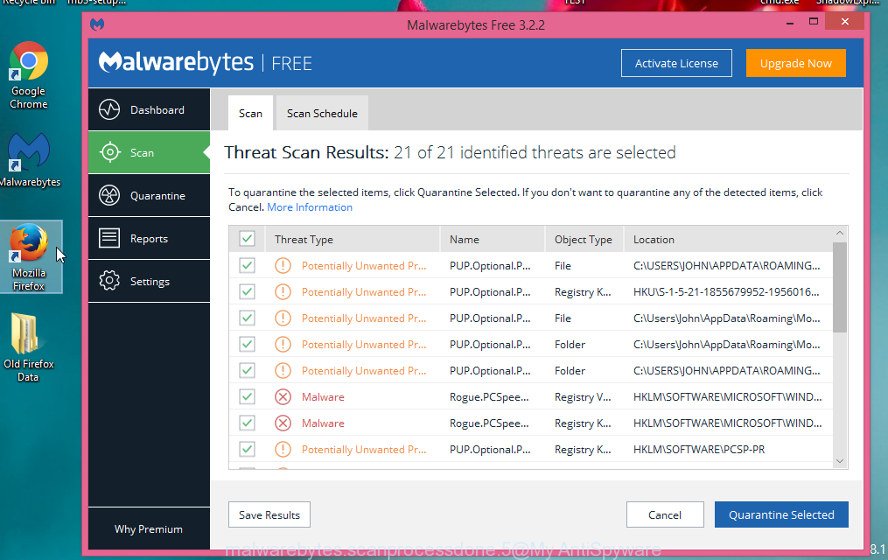
Click the following link to download MalwareBytes. Save it to your Desktop.
327299 downloads
Author: Malwarebytes
Category: Security tools
Update: April 15, 2020
Once the download is finished, run it and follow the prompts. Once installed, the MalwareBytes Free will try to update itself and when this process is finished, press the “Scan Now” button . MalwareBytes Anti Malware (MBAM) utility will begin scanning the whole PC system to find out adware responsible for T.incomingtracker.com pop-up advertisements. A system scan can take anywhere from 5 to 30 minutes, depending on your system. While the MalwareBytes Free is scanning, you can see number of objects it has identified either as being malicious software. Once you’ve selected what you want to get rid of from your computer click “Quarantine Selected” button.
The MalwareBytes AntiMalware is a free program that you can use to get rid of all detected folders, files, services, registry entries and so on. To learn more about this malware removal tool, we suggest you to read and follow the tutorial or the video guide below.
Block T.incomingtracker.com pop ups and other intrusive web-sites
It is also critical to protect your web-browsers from harmful webpages and ads by using an adblocker program like AdGuard. Security experts says that it will greatly reduce the risk of malicious software, and potentially save lots of money. Additionally, the AdGuard may also protect your privacy by blocking almost all trackers.
AdGuard can be downloaded from the following link. Save it on your Microsoft Windows desktop.
26906 downloads
Version: 6.4
Author: © Adguard
Category: Security tools
Update: November 15, 2018
After the downloading process is complete, launch the downloaded file. You will see the “Setup Wizard” screen as displayed below.

Follow the prompts. Once the setup is complete, you will see a window as displayed on the image below.

You can click “Skip” to close the install program and use the default settings, or click “Get Started” button to see an quick tutorial that will assist you get to know AdGuard better.
In most cases, the default settings are enough and you do not need to change anything. Each time, when you launch your PC system, AdGuard will start automatically and block ads, T.incomingtracker.com redirect, as well as other malicious or misleading webpages. For an overview of all the features of the program, or to change its settings you can simply double-click on the AdGuard icon, that is located on your desktop.
Tips to prevent T.incomingtracker.com popup ads and other unwanted software
In many cases, the free software setup file includes optional apps such as this adware that responsible for the appearance of T.incomingtracker.com ads. So, be very careful when you agree to install anything. The best way – is to choose a Custom, Advanced or Manual installation option. Here disable all additional programs in which you are unsure or that causes even a slightest suspicion. The main thing you should remember, you do not need to install any third-party programs which you do not trust! The only one thing I want to add. Once the freeware is installed, if you uninstall this software, the intrusive T.incomingtracker.com popup advertisements will not be uninstalled. This must be done by yourself. Just follow the steps above.
Finish words
After completing the few simple steps outlined above, your personal computer should be clean from this adware and other malware. The Chrome, IE, Mozilla Firefox and Microsoft Edge will no longer display unwanted T.incomingtracker.com web page when you surf the Net. Unfortunately, if the tutorial does not help you, then you have caught a new ‘ad supported’ software, and then the best way – ask for help.
Please start a new thread by using the “New Topic” button in the Spyware Removal forum. When posting your HJT log, try to give us some details about your problems, so we can try to help you more accurately. Wait for one of our trained “Security Team” or Site Administrator to provide you with knowledgeable assistance tailored to your problem with the annoying T.incomingtracker.com redirect.


















